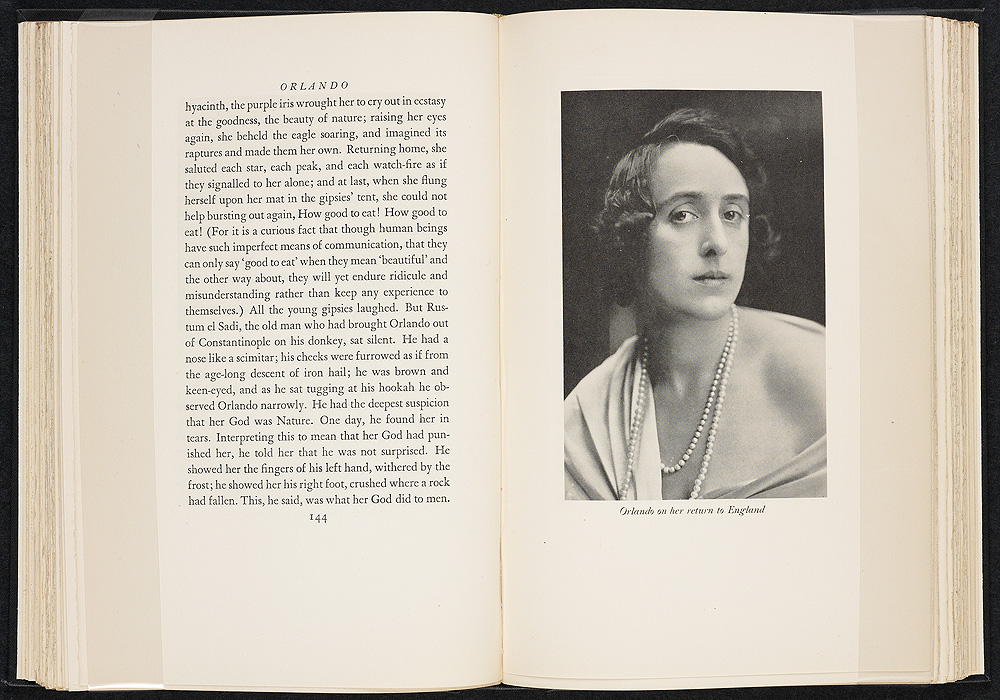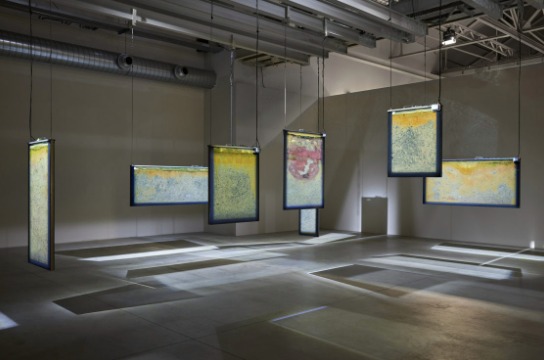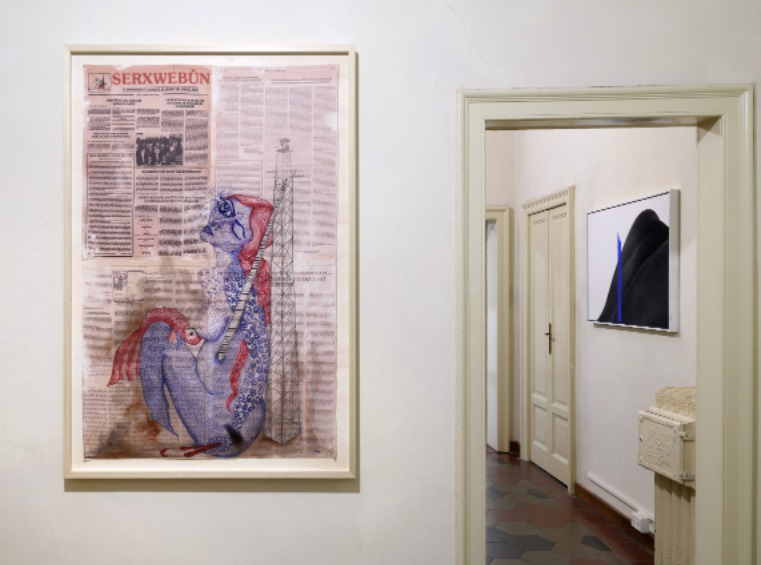A monthly review curated by the Mass Media and Culture team
Embrace the dull pulse of growing pains.
A transformation so deep it can be considered a metamorphosis that requires the hostage of our whole self. A process so human it fills mythology. Like Sisyphus pushing the boulder, we are bound to a cycle of change. Becoming unrecognizable to some, and somehow still the same person to our best friends from childhood with whom it’s always like we’ve traveled back in time.
Metamorphosis is often explored in art through the body, our physical forms, something tangible and obvious. It is way too often reduced only to a butterfly emerging from a chrysalis: failing to acknowledge what came before. The complete destruction of what once was.
From that, the MMC team curated a newsletter that mirrors that feeling as we entered April. There’s something special about the transition from winter to spring. Maybe the astrological calendar was onto something – the new year truly starts with fiery Aries.
For when the sun finally comes out, that melts away our cold winter layers protecting the raw insides, not yet ready to be exposed. And out comes someone new, barely ready to be thrown into the spin cycle of the upcoming eclipse season. All we can do is repeat to ourselves the clichés, everything happens for a reason or to trust the universe has a plan.
Mercedes Lovato
What To Read:
- “Metaphors” by Sylvia Plath
Metaphors
I’m a riddle in nine syllables,
An elephant, a ponderous house,
A melon strolling on two tendrils.
O red fruit, ivory, fine timbers!
This loaf’s big with its yeasty rising.
Money’s new-minted in this fat purse.
I’m a means, a stage, a cow in calf.
I’ve eaten a bag of green apples,
Boarded the train there’s no getting off.
Engaging with anxiety, poet Sylvia Plath embraces her metamorphosis of pregnancy. Through her confessional writing, Plath entertains playful metaphors to characterize her concerns and worries. Though light-hearted comments open the poem; progressively the Poet alludes to being a ‘means’ and that there is no way out. Ultimately, the real metamorphosis of pregnancy left Plath questioning her body and soul.
Recommended by Jonathan Mckenzie
- “Orlando” by Virginia Woolf
The 1928 novel by Virginia Woolf “Orlando” unfolds throughout three centuries of transformations and changes of the protagonist. Orlando, a man, after living for over one hundred years without aging, one morning, after sleeping for several days, wakes and finds he has metamorphosed into a woman. Orlando will stay biologically female for the rest of the book, which spans another two centuries. Woolf skillfully tells the story of a life, following both the masculine and feminine perspectives that find their meeting point in the main character. Orlando is still the same person, with the same personality and intellect, and as the story progresses everything else becomes irrelevant.

Recommended by Camilla Massaglia
What To Listen
Recommended by Aliki Vareltzidi (ft. Joe Akiki and Elena Getici)
What To See
1. Apollo and Daphne by Theodore Chassériau, 1845
Théodore Chassériau (1819-1856) was a French romantic painter best known for his history painting, often depicting mythological subjects as he does in this painting which depicts Apollo and Daphne from Ovid’s Metamorphoses. In this Greek myth, Apollo falls in love with a nymph named Daphne, who flees from the god. She asks her father, a river god, to help her and he transforms her into a laurel tree. Apollo’s love never disappears, and thus laurel leaves become sacred to him. Chassériau depicts the part of the myth where she metamorphs into the tree, but unlike most portrayals of the scene where Daphne’s transformation begins with her hair and fingers turning into branches, Chassériau shows a transformation that is not merely external but also takes place within. Her arms stretch above her head like branches and her hair blows in the breeze like leaves, as well as her body takes the form of a tree trunk.
Recommended by Eve Hadjisotiriou
2. Metamorphosis and Butterflies by M. C. Escher
Escher’s masterpiece, which metaphorically represents a life cycle, recalls the growth and evolution undergone by a living being: the birth of the individual, potentially metamorphic, blooms into more developed entities and, near to its death, goes back to its original form. It begins with the word metamorphose forming a grid pattern and then becoming a black-and-white checkered pattern. The latter then becomes tessellations of reptiles, a honeycomb, insects, fish, birds, a pattern of three-dimensional blocks with red tops, the Italian coastal town of Atrani, a chessboard, a checkered wall, and, finally again, it returns to the word metamorphose. Hence, our existence is a never-ending circular motion of vital energies.
Recommended by Elena Getici
What to Watch
1. Death, Love & Robots:
- Zima Blue (episode): In pursuit of the grander truth, the Artist known as ‘Zima’ keeps modifying himself in order to explore the vast cosmos. With each modification, Zima becomes more formidable, more intelligent, and more aware; and while hunting for the purpose of its existence, it loses touch with what that is.
- When the Yogurt Took Over (episode): After scientists morph a strain of yogurt into a hyper-intelligent sentient being, it soon assumes executive control. And while humans have been living in prosperity under the yogurt’s rule, are we okay with it advancing without us?
2. The Midnight Gospel (all episodes)
A novice space podcaster (Clancy) from the Chromatic Ribbon dimension owns an unlicensed multiverse simulator, which he uses to transform into custom avatars and travel to simulated universes to interview all kinds of unique creatures.
Note: These space interviews are actually based on a real-life podcast by creator Duncan Trussell, with topics mainly focusing on self-transformation through meditation, art, examining emotions, and dealing with mental illness and grief.
Recommended by Joe Akiki
3. Dead Poets Society
John Keating, an English teacher, joins the staff of an all-boys prep school full of students that come from conservative families. He tries to teach them something worthwhile, in an eccentric manner, all the while being careful not to step on any of his superiors’ or parents’ toes. Keating (played by Robin Williams), essentially teaches his students to make use of every opportunity they get, “carpe diem, seize the day”. You can see how the students go through metamorphosis, becoming more spontaneous and optimistic throughout the film.
Recommended by Elena Kotseva
What To Do
1. “Metaspore” (February 24 – July 24, 2022) – Pirelli Hangar Bicocca, free admission: In the twenty installations (from 2010 to today) by Anicka Yi we are introduced to an investigation of the concepts of metamorphosis, interdependence, ecosystem, and symbiosis through a sensory and synesthetic experience that gives us an insight on how the artist perceives her practice, while also facing the contamination between biology, politics, identity, social justice, and philosophy.
2. “Useless Bodies?” (31 Mar – 22 Aug 2022) – Fondazione Prada, €7,50 for students in Milan: Through a series of immersive and suggestive installations we are shown the visual proof of how the condition of the body shifted from fulfilling a central role to becoming almost superfluous while trying to think about our bodies future. The two artists, Elmgreen & Dragset, have always been attracted by the theme of metamorphosis and change, both concerning a specific theme and a broader one such as growing up and identity.
Recommended by Beatrice del Core
“Signs of me. The body, a stage.” (02 April – 25 June 2022) – Casa Testori: the show continues and builds on the legacy of 1960’s feminist artists. Continuing on not only the theme of metamorphosis but of the relation to the body and self. Emphasizing the violence and sexism permitted by contemporary power structures set in the beautiful villa. Six artists draw connections to Carol Rama and the body as a space for artistic expression.
Recommended by Mercedes Lovato


